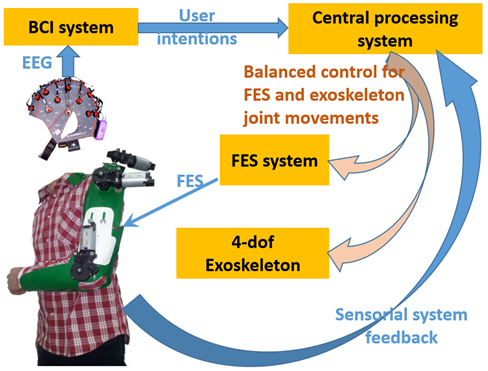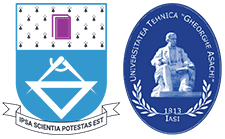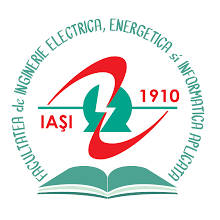HYBRID BCI-EXOSKELETON SYSTEM FOR UPPER LIMB REHABILITATION
Project code: PN-III-P1-1.1-TE-2019-1753, Contract No.: TE 114/2020
Abstract
The HBES project proposes an integrated solution prototype for interactive sequential neuromotor recovery in the upper limb. Its main objective is to design and implement a BCI-driven exoskeleton&FES hybrid modular system for the upper limb that can identify the residual potential in patients with neuromotor deficiency due to central nervous system lesions and adapt their neuromotor recovery exercises to maximize the passive effects of the neuromor recovery process.

The system combines a hybrid motor imagery (MI) and evoked potentials (EP) – based BCI, a wearable lightweight exoskeleton and a FES neurostimulator. The BCI system detects in real time the user’s movement intention by reading and interpreting the EEG signals. The user intentions are translated into control commands by the central processing system for the FES system and the 4DOF exoskeleton. Limited clinical tests are taken into account.
Main Goal
The HBES project aims to design and implement a Brain-Computer Interface-driven exoskeleton&FES hybrid modular system for the upper limb rehabilitation process. The general objectives of the HBES project are:
1. Shared control human-machine. User intentions, behavior and residual movements are fused by the HBES system and helps the user to perform the activities of daily living (ADL) and rehabilitation exercises.
2. Novel design of an adaptive user interface. The end user will have the possibility to select the desired exercise and to tune different parameters of the system and of the exercise by BCI or by hand, depending on the severity of his/her impairment.
3. HBES prototype development and delivery. A complete HBES system will be designed, modelled, built and tested in the university’s research laboratories. Test benches will be designed in order to intensively test the HBES system in laboratory, in order to account for: reliable information from the sensorial and BCI system to support the adaptive user interface and the human-machine cooperative control; performance of the software modules; reliability of the hardware modules; reliable communication between the HBES system modules.
4. Validation of the HBES system in clinical environment. The final part of the project will address the limited clinical testing which will be supported by a group of medics from Clinical Rehabilitation Hospital of Iasi. The ethical commission approval will be obtained prior any trials, and all the participants will sign and informed consent. The aim will be to provide the “proof of concept” of the advantages of the HBES system.
5. Innovative idea to involve end-users in design and research from the start of the project. Information about end-users’ expectations should be gathered even from the early beginning of the project. This is clearly a lead towards getting good devices and services closest to the marked and likely to be easy adopted and used. Common brainstorming session with end-users, medics and research team members will be conducted in order to specify the requirements of the HBES system. These consulting sessions will be organized during the all evolvement of the project in order reach the performance objectives for all sub-systems while dering legal and ethical issues related to the delivered technology.
6. Maximization of the HBES project impact. Carefully conceived exploitation plan and dissemination (website, journal publication, target key stakeholders, etc.) are envisaged in order to maximize the HBES project impact. The maximization of the project outcomes will be addressed also by spin-off companies eager on exploiting innovative results of the HBES project as well as the HBES prototype, involvement of companies dealing with rehabilitative devices.


